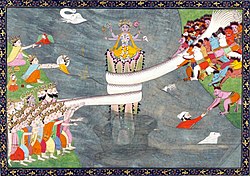


Mandara (Sanskrit: मन्दर, मन्दार; mandara, mandāra) is the name of the mountain that appears in the Samudra Manthana episode in the Hindu Puranas, where it was used as a churning rod to churn the ocean of milk. Shiva's serpent, Vasuki, offered to serve as the rope pulled on one side by a team of asuras, and on the other, by a team of devas. The Puranas refer to various sacred places on the hill that are also believed to be the abode of the avatar KrishnaasMadhusudana or the destroyer of the asura called Madhu, who was killed by Krishna and then covered by the Mount Mandara.
Kalidasa's Kumarasambhava refers to foot marks of Vishnu on the slopes of Mandara. [citation needed] The hill is replete with relics of bygone ages. [citation needed] Besides inscriptions and statues there are numerous rock cut sculptures depicting various Brahmanical images. [citation needed] The hill is equally revered by the Jains who believe that their 12th Tirthankara Shri Vasupujya attained nirvana here on the summit of the hill. [citation needed]

The depiction of the Churning of the Ocean of Milk became very popular in Khmer art, perhaps because their creation myth involved a Nāga ancestor. It is a popular motif in both Khmer and Thai art; one of the most dramatic depictions is one of the eight friezes that can be seen around the inner wall of Angkor Wat—the others being the Battle of Kurukshetra, Suryavarman's Military Review, scenes from Heaven and Hell, the battle between Vishnu and the asuras, the Battle between Krishna and Banasura, a battle between the gods and asuras, and the Battle of Lanka.
This Hindu mythology–related article is a stub. You can help Wikipedia by expanding it. |